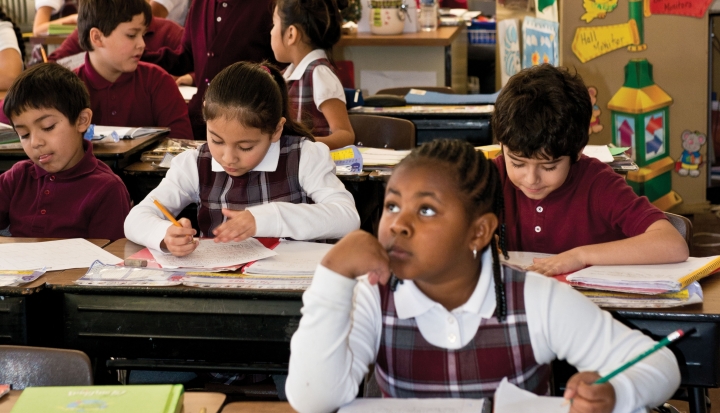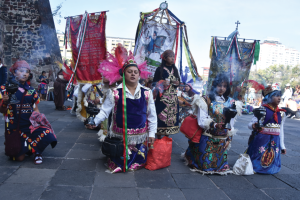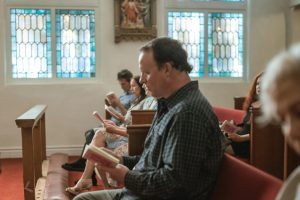Donors bent on saving struggling Catholic schools have deep pockets and even deeper commitment.
The closing of Our Lady of Sorrows School in Portland, Oregon was the last straw for business owner David Brands.
Seeing yet another Catholic school close its doors signaled to Brands that Catholic education was secure only for well-off schools and a few cutting-edge, alternative schools that had sophisticated fund-raising mechanisms already in place—such as the urban Cristo Rey schools, with their corporate work-study program that sends students out to work, often in professional settings, for five days per month.
Small parish schools in poor, working-class, or middle-class neighborhoods, urban and rural, seemed doomed. Those schools were barely hanging on, desperately begging donors for funds to keep their doors open for one more year, cutting programs and staff in a harsh blackboard jungle survival of the wealthiest.
Our Lady of Sorrows had been doing well and seemed to be on its way up. But then two years later it was closed. “With the right kind of leadership,” says Brands, “that school would be open today.”
Brands, president of Coast, a manufacturing business, and his fellow supporters of Catholic education were left searching for a solution. He and his family already sponsored a scholarship fund and volunteered at Catholic schools. His daughter Elizabeth had signed on with Notre Dame’s Alliance for Catholic Education (ACE), a service program that sends teachers to under-resourced Catholic schools and trains school administrators. All of that was surely part of the answer, but it wasn’t enough.
Then Brands heard about the Fulcrum Foundation in Seattle.
“To my knowledge, [Seattle is] the largest diocese to not have closed any schools in the past 15 years. Instead we’ve opened five new schools,” says Joe Womac, Fulcrum’s executive director. The foundation, which helps support the Archdiocese of Seattle’s under-resourced Catholic schools, raises money from people and foundations around Western Washington and beyond. It then donates funds to students and schools in need of assistance, dispersing nearly $3 million in 2011.
Beyond those capital infusions, it also helps schools become stronger. It is exactly the kind of safety net Our Lady of Sorrows could have used.
Fulcrum is one of about 20 or 30 similar stewardship foundations—or large-scale endowment funds—around the country. The Big Shoulders Fund in Chicago is one, as are the Inner-City Scholarship Funds of New York and Boston, the Jubilee Schools of Memphis, the Catholic School Development Program (“helping schools help themselves”) in Camden, New Jersey, and the Catholic Foundation of Los Angeles.
Not all are diocesan-wide; some focus only on inner-city schools. But all work in similar ways, transforming the schools’ business and governance models, jump-starting innovative programs, and offering scholarships to students.
They give grants to schools for academic programs or building maintenance, and may ask major donors, Catholic and non-Catholic, to adopt or partner with a school for two or three years.
Those patrons expect regular reports on how the school is using their time, talent, and treasure, insisting upon more transparency, accountability, and the best practices that have been shown to work elsewhere.
Some schools emerge looking like successful charter schools with a Catholic foundation of faith and teachings.
“We look to Fulcrum as a model of what we’d like to do here in Portland,” says Brands.
Giving big
While traditional family scholarship funds help individual students who need tuition assistance, these large-scale foundations save entire schools. There are only a few so far, but where they exist they’ve provided a safety net that doesn’t just save a school for one more year but instead has made many self-sufficient.
Holy Cross Father Joe Corpora, the U.S. bishops’ consultant on education and director of university-school partnerships for ACE, believes that kind of input from large-scale endowments is one of five keys to turning around the decline in Catholic schools. The others are outstanding principals; supportive, engaged pastors; a deep-seated understanding that Catholic schools belong to the entire church, not just the local parish; and vouchers or other ways to channel public tax dollars into the schools.
At the point that Our Lady of Sorrows started its downturn, it arguably had none of Corpora’s five factors going for it. Sadly, it was one of many schools in that fix. According to the National Catholic Education Association, 1,942 Catholic schools—nearly 24 percent—closed or were consolidated between 2000 and 2012. Enrollment during that time declined by 621,583 students—23.4 percent. Most of the children who experienced the wrenching closure of their school were elementary students.
Womac is certain those losses can be stopped and even reversed, but the transformative component is essential.
“Just giving money to a school every year is a Band-Aid—it isn’t sustainable,” says Elizabeth Brands, David Brands’ daughter and graduate of Notre Dame’s ACE program.
John Schoenig, director of Notre Dame’s Program for K-12 Educational Access, sounds the same note. “The goal can’t be survival,” he says. “It has to be true transformation. We have to develop models that won’t create dependence. In most cases the financial challenge isn’t the root of the school’s crisis. There are other, far more influential issues going on. The board may be ineffective, the teaching isn’t good, there’s no marketing. This is the hour that laypeople with vision can effect a systemic transformation in our schools.”
The Specialty Family Foundation in Los Angeles funded a nationwide study of best practices in Catholic schools. They found that sustainable schools have access to expert professional marketing and fund-raising, which increase enrollment, community awareness, and financial support—and reliably save schools.
“What we’re seeing in the last 10 years is a systemic shift from a funding model to a stewardship model on the part of philanthropists and major donors,” says Erik Goldschmidt, director of the Church in the 21st Century Center at Boston College. “There’s less interest today in unilateral giving and more interest in strategic investments.
“That means greater transparency from the schools, more data, more reporting on the outcome of the investments,” he says. “As for the schools, they’re shifting from just receiving to being more competent, data-driven programs. They’re more willing to engage in this strategic conversation.”
Goldschmidt acknowledges that “mission” schools serving the poorest neighborhoods will need support in perpetuity, but he doesn’t see that as being true for “middle-ring” schools—like Our Lady of Sorrows—that are in neighborhoods between the wealthiest and poorest. Donors were feeling especially frustrated with results from those schools, many of which were closing. “Do those donors withdraw their scholarships out of frustration, or do they get more involved, using their talents for a stewardship model?” he asks.
Most parish schools operate on a parochial governance model, with the principal in charge of day-to-day operations but the pastor effectively the chairman of the board, bogged down with overwhelming responsibilities and authority. That worked well for decades, especially when parishes had plenty of priests. Many if not most of the stewardship foundations insist upon a different governance model, with empowered school boards who share in the responsibility for approving budgets, administering fund-raising, and analyzing the school’s performance.
Foundations such as Fulcrum offer a vehicle for instituting such changes. The foundations are separate entities from their diocese but, Womac says, they are typically still empowered by the bishop. Pastors and principals are therefore more open to changes.
Money and heart
David Brands, hoping to launch a stewardship foundation in the Archdiocese of Portland, apologizes for how little progress he and his cohorts have made over the past five years. He’s probably being too hard on himself: Billionaires and bishops have largely propelled new large-scale endowment funds into existence.
The Diocese of Memphis created the trust that funded school superintendent Mary McDonald’s “Jubilee Schools.” In New York City, Cardinal Terence Cooke in 1971 worked with executives to set up the Inner-City Scholarship Fund to provide tuition assistance for low-income children.
On the other hand, Chicago business leaders inspired by Cardinal Joseph Bernardin founded the Big Shoulders Fund in 1986. One single family, James and Joan Peters, founded the Specialty Family Foundation, which focuses on 12 inner-city schools in Los Angeles.
Retired Archbishop of Seattle Alex Brunett, now serving as apostolic administrator of the Diocese of Oakland, California, was the impetus behind Fulcrum.
“We can keep the schools open if we want to,” says Brunett. “I’m appalled at the negative attitude some people have.”
Brunett is impatient about the usual reasons given for Catholic schools closing down—from the loss of nearly free staffing by women religious to the church’s sex abuse scandal that diverted money and focus away from education. “We had just as many lawsuits as any other diocese,” he says. “That doesn’t mean you stop living. It’s all a matter of priorities; if you have your heart in it, people are incredibly generous.”
Mary McDonald, the force behind the reopening of eight abandoned inner-city Catholic schools in Memphis, has described donors as investors. Her work was buoyed early on by a $10 million gift from a non-Catholic philanthropist who saw his gift as a good investment.
The Seattle archdiocese, Brunett says, accepted the reality of where the schools were and then recreated their school system. “We started with the principle that if we were going to invest in Catholic education, it wasn’t going to be just for the privileged but for every child. The only way we could do that was to raise a lot of money.”
In 2002 they founded Fulcrum, beginning with a goal of raising $40 million for an endowment fund. People responded, and the fund is at $70 million today. It doesn’t have to pay for Fulcrum’s operating expenses—an annual dinner does that, raising about $1 million each year.
In Chicago the numbers are even more staggering. Big Shoulders has raised $225 million over the past 25 years, including $6.3 million at a one-night event in 2012. Ninety-three inner-city Chicago schools have benefited from that fund. Big Shoulders has saved schools, students, and even neighborhoods according to a recent study from Notre Dame, which shows a link between Catholic school closures and increases in crime.
There’s no official umbrella organization for foundations like Fulcrum or Big Shoulders, no group with the mission to help start similar foundations in other dioceses, but Womac (who also came out of Notre Dame’s ACE program) has co-chaired a few ad hoc meetings of the two dozen or so new-style foundations for Catholic schools over the past eight years.
“We are more and more seeking each other out to learn about best practices, to find wheels that we don’t want to be recreating,” says Womac.
Dreams within reach
In Tacoma, Washington, Holy Rosary School in the gritty Hilltop neighborhood seemed as though it might break Fulcrum’s winning streak. By July 2011 enrollment had dipped to 94 students, and the parish served few families with children.
And yet just a couple miles away the child-friendly Spanish language Masses at Sacred Heart Parish were standing room only. “We looked for a funder who wanted to help Latinos,” says Womac. “They often can’t afford the cost of Catholic education but they also see cultural barriers.”
Fulcrum found a donor in New York City who made a transformative gift to Holy Rosary, which opened San Juan Diego Academy within the current school. Beginning with this year’s kindergarten and new pre-kindergarten, the school will grow by one year of bilingual instruction per year, meaning that next year will see a first grade that also enjoys half and half English and Spanish instruction and cultural immersion.
There’s a waiting list now, and the program is fully enrolled. It is the first Catholic bilingual grade school in the state of Washington, and every child will be tested at grade level in both English and Spanish.
Fulcrum and similar foundations still use much of their money for old-fashioned scholarships, at Holy Rosary and elsewhere. In Seattle Maurice Lekea’s two youngest children are students at St. Therese Academy. “[Fulcrum] made the dream possible,” says Lekea, a single father who works about 12 hours a day as a translator and French language coach. Lekea, educated in Catholic schools in the Democratic Republic of Congo, fled his country’s bloody wars and came to the United States, managing also to bring his five children, ages 11 to 21. Once settled, he sadly realized that Catholic schools in the United States were beyond his financial reach.
It was a friend who approached Father Michael Ryan, legendary pastor of St. James Cathedral in Seattle, on behalf of Lekea’s children. Ryan asked Lekea if he wanted his children to attend a Catholic school. “I told Father Ryan yes, I’ve been dreaming of that, but I cannot afford it. He told me, ‘By the grace of God, maybe something can be done.’ ”
Fulcrum provided the two youngest Lekea children with scholarship funds to attend the Catholic school of their choice. Lekea was pleased when they chose St. Therese, a school with about a 95 percent African American student body that has recently reinvented itself, again with Fulcrum’s help.
The current principal, Theresa Hagemann, found just 94 students when she arrived in 2010. Fulcrum helped the school get a $300,000 grant from the Bill and Melinda Gates Foundation plus additional seed money—nearly $150,000—from Seton Education Partners, a group founded by charter school entrepreneur Scott Hamilton.
St. Therese School became St. Therese Academy, a model for “blended technology learning,” with laptops for each student in fourth grade and up, and shared laptops in grades one to three. A summer marketing campaign plus buzz from parishioners and parents broadcast the news about the school.
Enrollment now stands at 170, and Hagemann expects those numbers to keep going up without a loss of effectiveness in the classroom. That’s because in each classroom at any given time, some students are working on lessons on their laptops while others work with the teacher or study independently.
“The Lekea family is a perfect example of why Fulcrum is here,” says Womac. “They’re a blessing in our lives, a real source of positive faith. As for St. Therese, the feeling in that community is: How can we continue this amazing progress? It’s also cheaper by about $3,000 per child to run the place.”
The Lekea story shows how these new foundations work: with scholarships but also stewardship and the transformation of each school.
“There’s great hope throughout the nation for Catholic schools,” says Elizabeth Brands. “We have a responsibility not just from a faith standpoint but from a social justice standpoint.”
Lekea, a friendly man with a ready laugh, recently teased his children about going back to their old public schools. His joke didn’t go over well. “No,” they told him. “We are not going back.”
This article appeared in the February 2013 issue of U.S. Catholic (Vol. 78, No. 2, pages 22-26).
Image: Tom A. Wright












Add comment